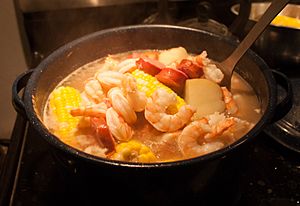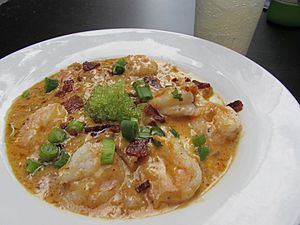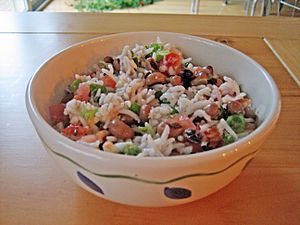Lowcountry cuisine facts for kids

Lowcountry cuisine is a special kind of cooking found along the coasts of South Carolina and Georgia. It's different from other Southern cooking because of its unique location, history, and people.
This cooking style uses lots of fresh seafood from the coast. It also has strong influences from African cuisine. This makes it similar to the famous foods of New Orleans and Cajun cuisine in Louisiana.
The Lowcountry region covers the coastal parts of South Carolina and Georgia. Most people agree it includes the area from Pawleys Island, South Carolina down to the Savannah River at the Georgia border. Sometimes, it's thought to include even more of the coastal plain. This geography is very important for the food.
The many estuaries (where rivers meet the sea) provide plenty of shrimp, fish, crabs, and oysters. Before refrigerators, these foods were only available near the coast. The marshlands in South Carolina were also perfect for growing rice. Because of this, rice became a very important part of daily meals.
Contents
Delicious Lowcountry Dishes
Lowcountry cuisine is known for its fresh ingredients and unique flavors. Many dishes use seafood and rice, which are plentiful in the region.
Soups and Starters
- Cooter soup: This is a type of Turtle soup.
- She-crab soup: A creamy soup made with crab meat and roe (crab eggs).
- Sweet potato and crab soup: A warm soup combining sweet potatoes and crab.
- Gumbo: A thick stew with meat or seafood, often served with rice.
- Brunswick stew: A hearty stew with different meats and vegetables.
Main Dishes with Meat and Seafood

- Catfish stew: A stew made with catfish, often with tomatoes and other vegetables.
- Lowcountry boil: Also called "Frogmore stew," this is a big pot of shrimp, sausage, corn, and potatoes, all boiled together.
- Country Captain: A chicken dish cooked with curry powder, tomatoes, and raisins.
- Shrimp and grits: A very popular dish with creamy grits topped with shrimp in a savory sauce.
- Shrimp kedgeree: A dish with rice, flaked fish (often shrimp), hard-boiled eggs, and curry spices.
- Oyster roast: A fun event where oysters are steamed and eaten fresh from their shells.
- Crab cake: Patties made from crab meat, breadcrumbs, and seasonings, then fried or baked.
Rice Dishes

- Charleston red rice: Rice cooked with tomatoes, bacon, and other seasonings, giving it a reddish color.
- Perlau or chicken bog: Rice cooked with chicken, sausage, and spices, making a flavorful, hearty dish.
- Salmon and rice: A simple dish combining salmon with rice.
Side Dishes
- Hoppin' John: A traditional dish made with black-eyed peas and rice, often eaten for good luck.
- Fried cabbage: Cabbage cooked until tender, often with bacon or ham.
- Baked macaroni and cheese: A creamy, cheesy pasta dish baked until golden.
See also
 In Spanish: Cocina lowcountry para niños
In Spanish: Cocina lowcountry para niños

